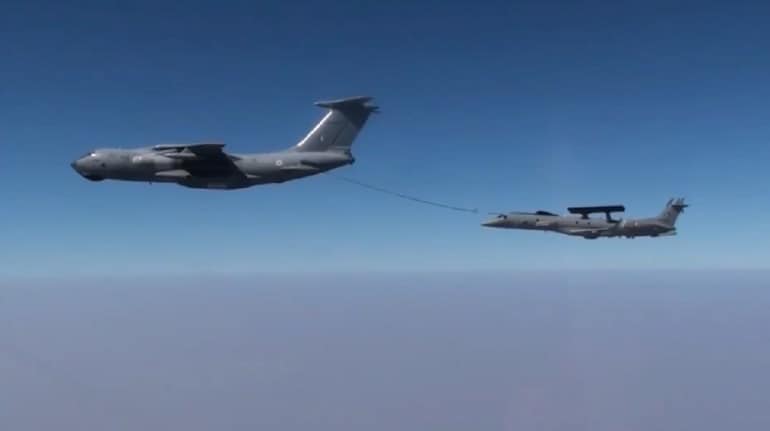SOURCE: AFI


As the Indian Air Force (IAF) faces increasing security challenges in a complex geopolitical environment, it must make a strategic decision—whether to continue its pursuit of the Multi-Role Fighter Aircraft (MRFA) program for short-term capability expansion or to prioritize long-term investments in indigenous engine programs, force multipliers, and critical infrastructure. The IAF’s new leadership, like their predecessors, has consistently championed the need for more fighter squadrons. However, without robust support systems like airborne warning platforms, aerial refueling, and advanced engine programs, focusing on fighter numbers alone might leave the force unprepared for future conflicts.
The MRFA program, which envisions the procurement of 114 advanced fighters from foreign manufacturers, has been a constant topic of discussion among IAF Chiefs of Air Staff (CAS) over the past few years. The idea behind the program is to address the dwindling number of fighter squadrons and enhance the IAF’s combat capabilities. However, despite multiple public statements, the program has seen little tangible progress, largely due to budgetary constraints, the complex procurement process, and competing defense priorities.
The IAF currently operates 31 squadrons, significantly below the sanctioned strength of 42. The MRFA is seen as a quick fix to this deficit, promising to fill this gap with new-generation aircraft that can execute multiple roles, from air superiority to ground attacks. However, the cost of acquiring and sustaining 114 fighters from foreign vendors is immense, potentially diverting funds from other critical areas that will have a greater long-term impact on the IAF’s operational effectiveness.
While increasing the fighter squadron count is undoubtedly important, the focus on this single metric risks oversimplifying the IAF’s broader capability needs. The contemporary battlefield demands more than just numbers—modern air forces rely heavily on force multipliers such as airborne early warning and control (AEW&C) systems, aerial refueling capabilities, electronic warfare assets, and advanced radar systems. Without these enablers, even a 5th-generation fighter force can be vulnerable, particularly in a peer conflict scenario where sophisticated adversaries can exploit gaps in surveillance, coordination, and endurance.
Currently, the IAF operates a limited number of AEW&C platforms like the Netra and IL-76 Phalcon systems, which fall short of the number needed to provide full coverage across India’s vast borders. Additionally, the IAF’s fleet of aerial refuelers is small, limiting the endurance of its fighters during long-range missions. There is little discussion in the public sphere about increasing these critical assets, even though they are indispensable in any future conflict involving peer adversaries such as China or Pakistan.
One area where the IAF could make a more profound long-term impact is by pressuring the Ministry of Defence (MoD) to invest in indigenous engine programs. A capable, indigenous jet engine would allow India to break free from its reliance on foreign suppliers and improve the IAF’s self-sufficiency. Currently, India’s Kaveri engine program and its iterations have made little progress, but with sustained investment and focus, they could eventually power future generations of fighters like the Advanced Medium Combat Aircraft (AMCA) and the Tejas Mk II.
Additionally, investing in cutting-edge testing facilities, simulators, and advanced weapons systems would give the IAF an edge in training and operational readiness. Such investments would also support India’s broader defense manufacturing ecosystem, contributing to the goals of self-reliance and technology development under the Atmanirbhar Bharat initiative.
It is essential for the IAF to shift from merely expanding its “capability” to also “capacity-building” through these force multipliers. In the event of a full-scale conflict, these assets are crucial for ensuring the IAF’s fighters, regardless of their generation, can operate effectively. Aerial refueling tankers, AWACS, Electronic Warfare (EW) aircraft, and unmanned systems are indispensable for providing real-time battlefield awareness, extending combat ranges, and enhancing the survivability of the fighter fleet.
With the current geopolitical situation in the Indo-Pacific region, where China is rapidly modernizing its air force and enhancing its own force multipliers, it is imperative that India does not lag behind. Rather than fixating on the squadron count, the IAF should press the MoD to loosen its purse strings to fund these vital systems and infrastructure, which will make a significant difference in any future high-intensity conflict.
The IAF stands at a critical crossroads. It can either continue to chase short-term gains by focusing on the MRFA program, a move that will undoubtedly improve its fighter squadron count but might leave it exposed in areas that truly determine modern airpower effectiveness. Or, it can take the bold step of prioritizing force multipliers, engine programs, and infrastructure investments—decisions that may not deliver immediate results but will provide long-lasting advantages in the years to come.